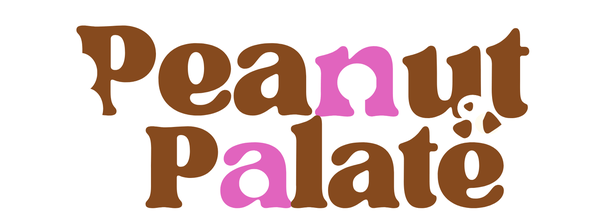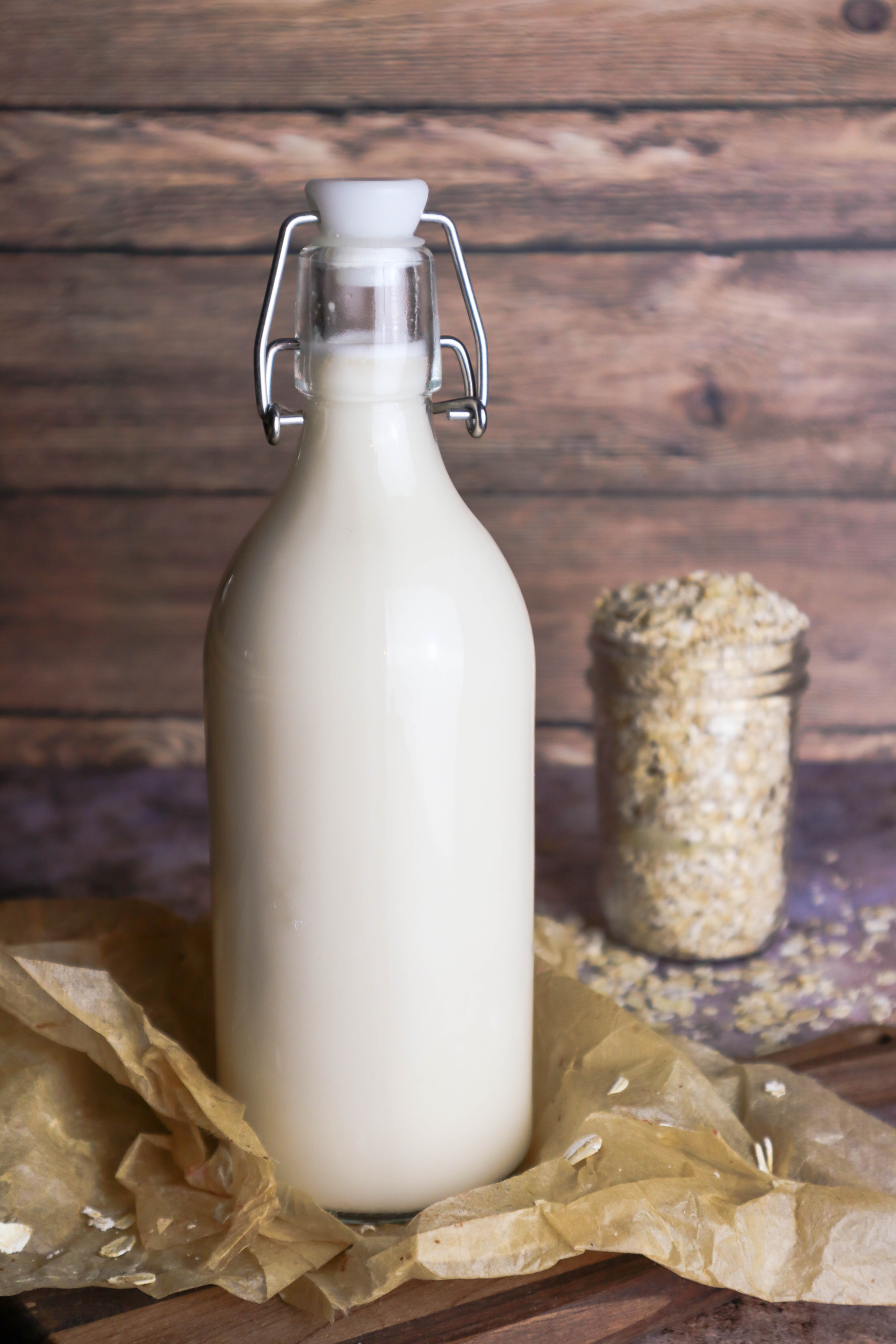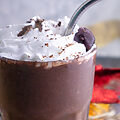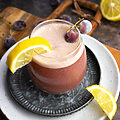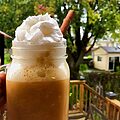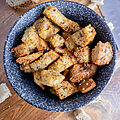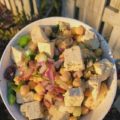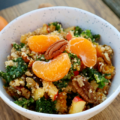How to Make Homemade Oat Milk (Plant Based)
Today we are learning How to Make Homemade Oat Milk (Plant Based)! Plant-based milk alternatives have been on the rise in the last decade. After the popularity of soy milk and almond milk, oat milk has been next in line! It’s being offered in Starbucks for your cup of coffee, in grocery store chains everywhere, being put in your morning smoothies, in oat milk ice cream and more! Many alternatives to dairy products use this popular milk (or other plant milks with similar additives) as a base.
There have been so many different brands popping up over the last few years. From Oatly (including their Barista Blend for lattes or iced coffee), Silk, Planet Oat and more. It’s creamy, nutty, sweet and overall delicious!
So why make it at home when you can buy any plant milk at the grocery store? Well, let’s take a look at the ingredients in Oatly milk: Oat base (water, oats). Contains 2% or less of: low erucic acid rapeseed oil, dipotassium phosphate, calcium carbonate, tricalcium phosphate, sea salt, dicalcium phosphate, riboflavin, vitamin A, vitamin D2, vitamin B12.
Oil & Phosphate Additives
What does all of that even mean? Dicalcium phosphate is a food additive, that, although FDA approved, has been linked to health problems. Not specifically only this chemical, but phosphate additives overall (including the dipotassium phosphate). Even in healthy young men, high-normal levels of phosphates in the blood are linked to heart disease. Additionally, it has a negative impact on bone health, calcium deposits and hardening of the heart arteries. That’s crazy!
And our consumption of phosphate additives has more than doubled since the 1990s with the addition of all the processed foods. If you’re drinking oat milk in your three-cups-a-day of coffee, or making matcha lattes or other foods using this milk, the phosphate piles up.
What about rapeseed oil? Or in general, other added oil like sunflower oil? Low erucic acid rapeseed oil is the oil that comes from the rapeseed plant, and the food-grade rapeseed oil is actually known as … canola oil! Canola oil a geneticially modified version of rapeseed oil that has lower levels or erucic acid. These lower levels make it food-grade as compared to industrial-level oil which is used for non-human consumption due to high levels of naturally occurring erucic acid.
The oil is heavily refined and bleached to clean it before using in food. But in the process of cleaning it, trans fatty acids are formed (as with other vegetable oils used as food additives). This begins to cause health issues, like increasing risk of heart disease and stroke.
So I read a lot about all the ingredients that went into the plant-based milks I was drinking multiple times a day. Suddenly, they didn’t seem like such a healthy choice anymore.
Homemade Milk is Easy!
Instead, making oat milk at home allows you to have complete control over the ingredients and their quality. You can choose organic oats and use filtered water, ensuring a cleaner and purer final product. By eliminating the additives and potential health concerns associated with commercial oat milk, you can enjoy a truly wholesome and nourishing alternative to cow’s milk.
Plus, the process of making oat milk is relatively quick and straightforward. It involves soaking the oats, blending them with water, and straining the mixture. The leftover oat pulp can even be repurposed in recipes like oatmeal cookies or used as a facial scrub! This minimizes waste and adds value to your homemade oat milk experience.
Why You’ll Love This Homemade Oat Milk
Creamy and Nutritious: Despite its minimal ingredient list, homemade oat milk is surprisingly creamy and packed with nutritional goodness. Oats are a fantastic source of dietary fiber, vitamins, and minerals, including iron, magnesium, and vitamin B. This wholesome combination provides a satisfying and nourishing beverage that can easily rival store-bought alternatives.
Cost-Effective and Eco-Friendly: By opting for homemade oat milk, you’ll save more money! But you’ll also contribute to a more sustainable lifestyle, which is a double win. Store-bought plant-based milks can be expensive, especially when consumed regularly. Making your own oat milk allows you to bypass the high price tags and reduce packaging waste associated with buying pre-packaged alternatives.
Supports a Plant-Based Lifestyle: Whether you follow a plant-based lifestyle or simply want to incorporate more plant-based options into your diet, this delicious oat milk is an excellent choice. It provides a nutritious and delicious alternative to dairy milk. This makes it easier to reduce your reliance on animal products in the long run.
A Healthier Choice
One Ingredient Milk: This recipe uses just two ingredients: water and oats! Not only is it incredibly simple to make, but it also offers a host of benefits that will make you fall in love with this homemade oat milk.
Free of Additives and Preservatives: Another significant advantage of homemade oat milk is that it contains no additives or preservatives, along with no added sugar. Many commercial plant-based milks contain stabilizers, emulsifiers, and artificial flavorings to enhance shelf life and taste. With homemade oat milk, you can enjoy a pure and natural beverage without any unnecessary ingredients.
Customize It!
Customizable to Suit Your Taste: One of the best aspects of making your own oat milk is the ability to customize it according to your preferences. Whether you prefer a hint of sweetness, a dash of vanilla, or a touch of cinnamon, you can easily tailor the flavors to suit your taste buds. You have full control over the sweetness level and can even experiment with different types of oats to achieve the consistency you desire.
Versatile in the Kitchen: Besides being a refreshing drink on its own, homemade oat milk is incredibly versatile in the kitchen. You can use it as a dairy milk substitute in various recipes, such as smoothies, baked goods, and even savory dishes like creamy soups and sauces. Its neutral flavor profile complements a wide range of ingredients, allowing you to get creative with your culinary endeavors.
Substitutions
Sweetener: You can use agave nectar or pure maple syrup as a liquid sweetener, if you don’t want unsweetened oat milk. For a raw sweetener, use pitted Medjool dates instead. If using maple syrup, make sure there is only one ingredient – just the maple syrup – on the label. This is not the pancake-style maple syrup with artificial sweeteners in it.
Oats: Use rolled oats for best results. Steel cut oats are not as processed, so they don’t make the milk have as much of a creamy texture. Instant oats (quick-cooking) are too fine, and make the milk more slimy. The texture and consistency of rolled oats makes the perfect balance, resulting in a velvety smooth oat milk that is both satisfying and enjoyable to drink.
To make organic oat milk, choose non-GMO, organic oats. For those with Celiac disease, choose certified gluten-free oats.
Homemade Oat Milk Recipe Notes
- Add liquid sweetener and cacao powder if making chocolate oat milk. You can adjust the amounts added as you blend and taste test. Start with 1 teaspoon of cacao powder and 1 tablespoon of pure maple syrup or agave nectar.
- Add a pinch of salt or a splash of pure vanilla extract, for flavor.
More Recipes You’ll Love
Orange Creamsicle Energy Balls
Two-Ingredient Mango Ice Cream
If you enjoyed this recipe on How to Make Homemade Oat Milk, then leave a comment and star rating! Don’t forget to tag your photos @peanut_palate on Instagram. Enjoy!
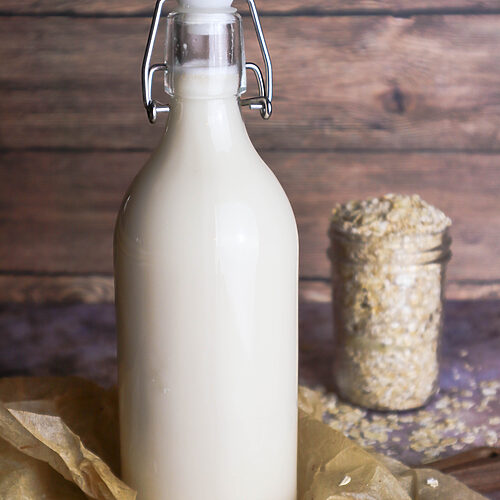
How to Make Homemade Oat Milk (Plant Based)
Equipment
- High-speed blender or food processor
- Cheesecloth, nut milk bag or clean T-shirt
Ingredients
- 1 cup dry oats
- 4 cups room temperature water
- pure maple syrup or agave nectar as desired
Instructions
- Blend all ingredients until smooth. Add some Medjool dates, agave nectar or pure maple syrup if additional sweetness is desired.
- Strain the liquid through a cheesecloth into a large bowl.
- Taste the milk. If it tastes slimy, then strain it once more through the cheesecloth.
- Once the straining step is complete and the oat is milk is at the desired consistency, use in recipes as a substitute for store-bought oat milk.
- See storage instructions below.
Notes
-
Storage
- Store in an airtight container or milk jug for up to four days. Make sure to give the bottle a good stir or shake before using.
